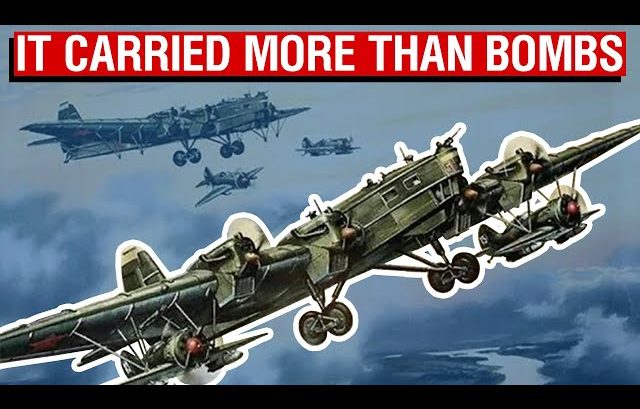The Tupolev TB-3 is a four-engine Soviet heavy developed in the late 1920s. It was the first all-metal, four-engine, monoplane bomber to enter service, and transformed the Soviet Air Force’s capabilities.
Design Origins
The TB-3’s story begins in 1925 with the Soviet Air Force. During the 1920s, the Soviet Union didn’t have the required facilities in which it could build its airframes, nor give them the required equipment in the numbers requested.
As a result, the development of the bomber was so slow that several other Tupolev projects took to the air after being started after it.
Production and Problems
The first production aircraft rolled out on January 4, 1932. Unfortunately, by this point, the production aircraft had grown heavy, resulting in poor flight performance when the first units were delivered.
The cause of the weight gain was due to a number of things- the switching from imported to locally produced alloys for much of the airframe, the addition of combat equipment that is sometimes not accounted for, the use of heavy electric cables despite currents being trivial and poor quality and inexperienced factory workers.
Because of this, an urgent weight reduction program was made, with complete disregard for safety. The structure was simplified, wing ribs were removed, and in some extreme cases, the thickness of the fuselage structure was reduced. Despite this, when the plane flew again, this didn’t lead to any catastrophic structural failures.
Performance Stats
Production went full steam ahead, and by 1933, factory 22 was producing two TB-3s every three days and was now powered by the M-17 engine.
By the start of the year, nearly 400 TB-3s had already been built and delivered. This meant that the Soviet Union now had the most powerful bomber force in the world- a distinction that they would hold for most of the 1930s.
Seeking Further Improvement
Despite having a solid bomber force, the VVS was still hungry for improvement, specifically, range.
The Soviet Union itself was extremely vast, and it had potential enemies on both Eastern and Western borders. As a result, range was considered more important than payload among many senior officers.
Salvation was found in the M-34R engine that featured a reduction gear. The take-off run was reduced, the climb to 3,000 m went from 29 minutes down to 17, the top speed increased by up to 20kph, and propeller noise was significantly lessened.
Service Life
There’s not much information on the service life of the TB-3, but it paints a good picture. With over 800 being built, this plane would see service throughout the 1930s, and all the way up to the end of WWII.
TB-3s were also featured at the Battle of Khalkin Gol against Imperial Japan, and the Winter War in Finland. However, the biggest involvement of TB-3s was during the Second World War after the German invasion of the Soviet Union.
By the summer of 1941, the TB-3ss was well and truly showing its age, with a number of more advanced bomber designs being introduced in service. It was withdrawn from the frontlines in 1939, and many TB-3s had been converted into transport variants known as G-2.



